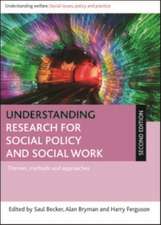Analyzing Repeated Surveys: Quantitative Applications in the Social Sciences, cartea 115
Autor Glenn Firebaughen Limba Engleză Paperback – 7 apr 1997
Din seria Quantitative Applications in the Social Sciences
-
 Preț: 323.09 lei
Preț: 323.09 lei -
 Preț: 285.10 lei
Preț: 285.10 lei -
 Preț: 285.33 lei
Preț: 285.33 lei -
 Preț: 274.06 lei
Preț: 274.06 lei -
 Preț: 285.37 lei
Preț: 285.37 lei -
 Preț: 321.52 lei
Preț: 321.52 lei -
 Preț: 330.81 lei
Preț: 330.81 lei -
 Preț: 322.61 lei
Preț: 322.61 lei -
 Preț: 321.79 lei
Preț: 321.79 lei -
 Preț: 323.15 lei
Preț: 323.15 lei -
 Preț: 273.46 lei
Preț: 273.46 lei -
 Preț: 275.42 lei
Preț: 275.42 lei -
 Preț: 277.33 lei
Preț: 277.33 lei -
 Preț: 322.06 lei
Preț: 322.06 lei -
 Preț: 286.18 lei
Preț: 286.18 lei -
 Preț: 285.71 lei
Preț: 285.71 lei -
 Preț: 322.06 lei
Preț: 322.06 lei -
 Preț: 321.52 lei
Preț: 321.52 lei -
 Preț: 322.30 lei
Preț: 322.30 lei -
 Preț: 285.47 lei
Preț: 285.47 lei -
 Preț: 322.61 lei
Preț: 322.61 lei -
 Preț: 321.79 lei
Preț: 321.79 lei -
 Preț: 323.15 lei
Preț: 323.15 lei -
 Preț: 323.36 lei
Preț: 323.36 lei -
 Preț: 322.41 lei
Preț: 322.41 lei -
 Preț: 323.42 lei
Preț: 323.42 lei -
 Preț: 322.61 lei
Preț: 322.61 lei -
 Preț: 284.99 lei
Preț: 284.99 lei -
 Preț: 285.47 lei
Preț: 285.47 lei -
 Preț: 284.99 lei
Preț: 284.99 lei -
 Preț: 289.18 lei
Preț: 289.18 lei -
 Preț: 287.82 lei
Preț: 287.82 lei -
 Preț: 316.12 lei
Preț: 316.12 lei -
 Preț: 288.96 lei
Preț: 288.96 lei -
 Preț: 316.71 lei
Preț: 316.71 lei -
 Preț: 314.98 lei
Preț: 314.98 lei -
 Preț: 317.26 lei
Preț: 317.26 lei -
 Preț: 314.60 lei
Preț: 314.60 lei -
 Preț: 289.95 lei
Preț: 289.95 lei -
 Preț: 289.18 lei
Preț: 289.18 lei -
 Preț: 315.36 lei
Preț: 315.36 lei -
 Preț: 314.98 lei
Preț: 314.98 lei -
 Preț: 314.38 lei
Preț: 314.38 lei -
 Preț: 316.33 lei
Preț: 316.33 lei -
 Preț: 316.51 lei
Preț: 316.51 lei -
 Preț: 288.41 lei
Preț: 288.41 lei -
 Preț: 316.51 lei
Preț: 316.51 lei
Preț: 314.76 lei
Nou
Puncte Express: 472
Preț estimativ în valută:
60.24€ • 65.41$ • 50.60£
60.24€ • 65.41$ • 50.60£
Carte tipărită la comandă
Livrare economică 22 aprilie-06 mai
Preluare comenzi: 021 569.72.76
Specificații
ISBN-13: 9780803973985
ISBN-10: 0803973985
Pagini: 80
Dimensiuni: 140 x 216 x 5 mm
Greutate: 0.1 kg
Ediția:1
Editura: SAGE Publications
Colecția Sage Publications, Inc
Seria Quantitative Applications in the Social Sciences
Locul publicării:Thousand Oaks, United States
ISBN-10: 0803973985
Pagini: 80
Dimensiuni: 140 x 216 x 5 mm
Greutate: 0.1 kg
Ediția:1
Editura: SAGE Publications
Colecția Sage Publications, Inc
Seria Quantitative Applications in the Social Sciences
Locul publicării:Thousand Oaks, United States
Cuprins
Introduction
Distinguishing Age, Period, and Cohort Effects
Aggregate Trends
Decomposing Aggregate Trends
A General Model for Decomposing Aggregate Change
Detecting Change in Individual-Level Relationships
Summary
Analyzing Social Change
Distinguishing Age, Period, and Cohort Effects
Aggregate Trends
Decomposing Aggregate Trends
A General Model for Decomposing Aggregate Change
Detecting Change in Individual-Level Relationships
Summary
Analyzing Social Change
Notă biografică
Glenn Firebaugh is the Roy C. Buck Professor of Sociology and Demography at the Pennsylvania State University, and former Editor of the American Sociological Review. He is the author of The New Geography of Global Income Inequality (Harvard, 2003) and Seven Rules for Social Research (Princeton, 2008). Currently, he is investigating racial inequality in neighborhood conditions as well as the final inequality in age at death.
Descriere
Repeated surveys allow researchers the opportunity to analyze changes in society as a whole. This book includes: a discussion of the classic issue of how to separate cohort, period and age effects; methods for modelling aggregate trends; and methods for estimating cohort replacement's contribution to aggregate trends.











